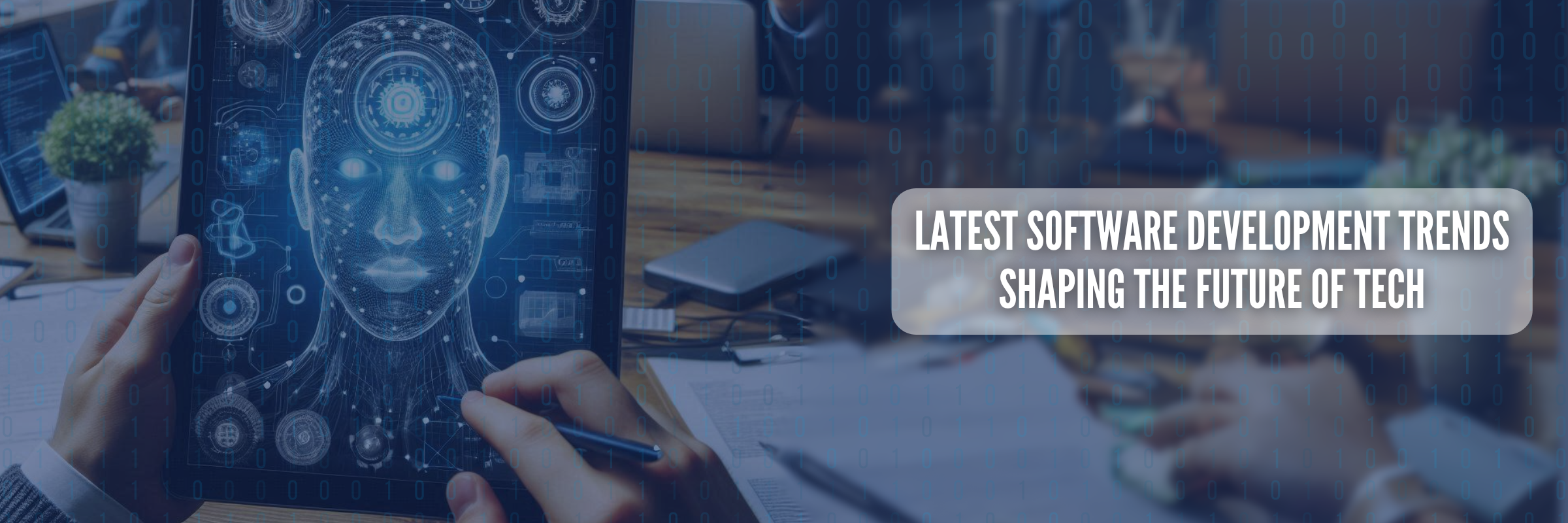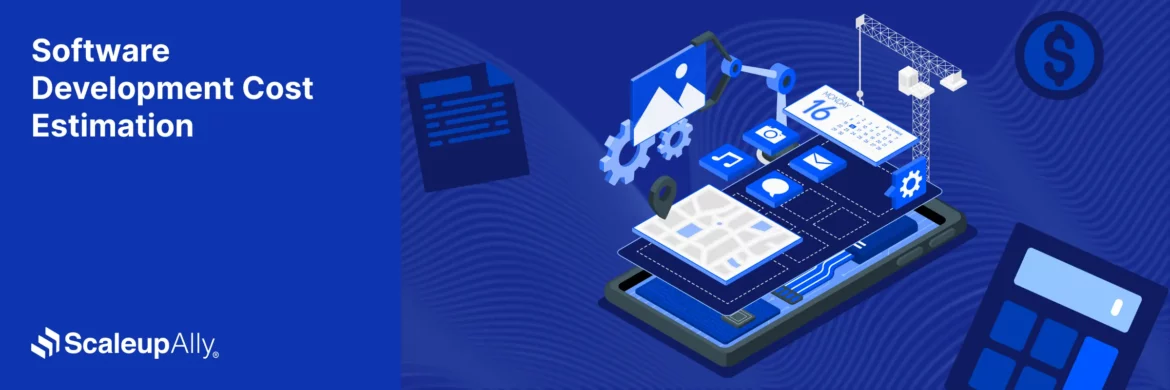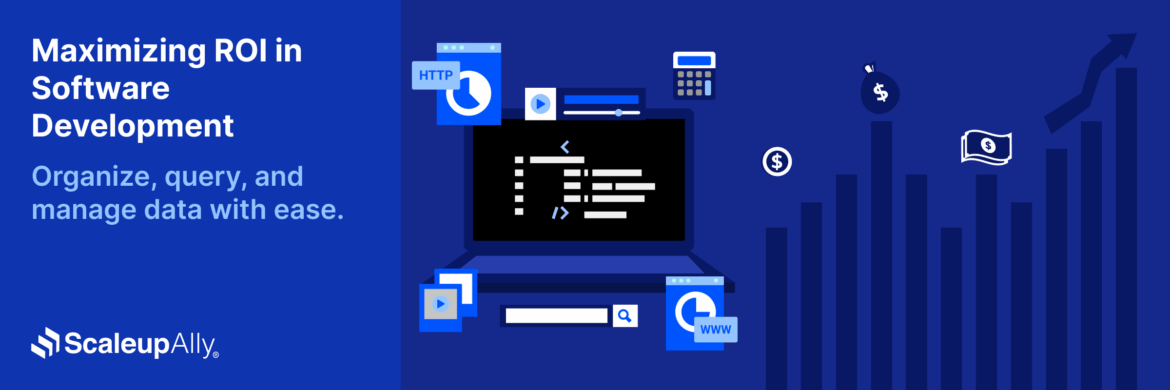
12 Software Development Trends Shaping the Future of Tech
Suprabhat Sen | June 29, 2024 , 15 min read
Table Of Content
In the world of software development, yesterday’s cutting-edge tech can feel like a dusty floppy disk today. The industry is a whirlwind of innovation, with new trends emerging faster than you can say “agile methodologies.”
Keeping pace isn’t just about bragging rights; it’s about staying relevant and building the future, not clinging to the past.
So, let’s explore the 12 current software development trends that are providing a glimpse into the future software development technologies and shaping the next generation of this industry.
Key Takeaways
- Cloud computing, AI, and blockchain are transforming software development, offering scalable, secure, and cost-efficient solutions for modern businesses.
- Low-Code/No-Code platforms and PWAs empower teams to build functional applications quickly while enhancing user engagement and accessibility.
- Edge computing, AR/VR, and immersive experiences accelerate real-time decision-making and redefine interactions between digital and physical environments.
- DevOps practices, outsourcing, and emerging programming languages improve collaboration, efficiency, and access to specialized development expertise globally.
- Predictive analytics and data-driven insights enable personalized experiences, proactive strategies, and innovation, helping businesses stay competitive and agile.
12 Latest Trends in Software Development
From new programming languages to cutting-edge methodologies, keeping abreast of the latest trends is essential for developers, businesses, and tech enthusiasts alike.
Here are the 12 most impactful trends shaping the world of software development.
Let’s explore how these innovations are revolutionizing how we build and interact with software.
1. Cloud Computing
Gone are the days when businesses had to rely on bulky, expensive servers that occupied significant physical space and required substantial maintenance. Today, the advent of cloud-based development has revolutionized the IT landscape.
By leveraging cloud computing, companies can now enjoy unmatched scalability, allowing them to adjust their computing resources on demand without the need for additional hardware investments.
This flexibility means businesses can swiftly respond to market changes and scale their operations up or down based on their current needs.
Moreover, cloud-based development significantly enhances cost efficiency. Companies no longer need to invest heavily in physical infrastructure or allocate substantial budgets for server maintenance and upgrades.
Instead, they can opt for a pay-as-you-go model, paying only for the resources they actually use, which helps in better budget management and cost savings.
It’s no surprise that the global cloud computing market is experiencing exponential growth. According to Gartner, by 2028, cloud computing will shift from being a technology disruptor to becoming a necessary component for maintaining business competitiveness.
This growth underscores the increasing reliance on cloud solutions by businesses worldwide, driven by numerous benefits such as enhanced collaboration, remote accessibility, and improved disaster recovery options.
As more organizations migrate to the cloud, they unlock new opportunities for innovation and efficiency, positioning themselves better in an ever-evolving digital landscape. This is one of the latest software development trends that is crucial in ensuring that organizations remain competitive and can fully leverage the advantages of cloud technology.
2. Blockchain Revolution
Blockchain technology, known for its tamper-proof, distributed ledger system, is revolutionizing industries far beyond finance. By ensuring secure data storage and precise transaction tracking, blockchain holds immense potential in software development.
For instance, in supply chain management, blockchain can enhance transparency and traceability, allowing stakeholders to track products from origin to destination, ensuring authenticity and reducing fraud.
In secure voting systems, blockchain’s ability to provide a verifiable and immutable record can help prevent electoral fraud and ensure that votes are accurately counted.
Additionally, blockchain applications extend to healthcare for secure patient data management, real estate for simplifying property transactions, and intellectual property for protecting digital rights.
According to Statista, the blockchain market is expected to reach $39.7 billion by 2025, indicating a growing demand for this technology. As industries continue to explore and implement blockchain solutions, the technology’s role in enhancing security, efficiency, and trust across various sectors is becoming increasingly evident.
This trend aligns with the broader movement towards adopting trending technologies in software development, highlighting blockchain’s significant impact on modernizing and securing digital ecosystems.
3. AI Everywhere
Artificial intelligence (AI) is no longer the stuff of science fiction. It has rapidly evolved from a futuristic concept to a mainstream technology that is reshaping numerous aspects of our daily lives and various industries.
From chatbots to machine learning algorithms, AI is transforming how software interacts with users and automates complex tasks.
Chatbots, for instance, have become present everywhere in customer service, providing instant responses and support to customers around the clock. These AI-powered virtual assistants can handle a wide range of inquiries, from simple questions to more complex problem-solving, significantly improving customer experience and reducing the need for human intervention.
Machine learning algorithms, on the other hand, are being employed to analyze vast amounts of data, identify patterns, and make predictions with remarkable accuracy.
This capability is revolutionizing fields such as healthcare, finance, and marketing, where data-driven insights are crucial for decision-making and strategy development.
The global AI market is experiencing exponential growth, driven by continuous advancements in technology and increasing adoption across various sectors.
According to Statista, the market is expected to grow by 28.46% (2024-2030) resulting in a market volume of US $826.70 billion in 2030. This growth is fueled by the expanding use cases of AI, ranging from autonomous vehicles and smart home devices to sophisticated analytics and personalized recommendations.
As AI continues to evolve, it holds the potential to drive significant innovations and efficiencies, making it an indispensable tool in the modern technological landscape.
Whether through enhancing user interactions, optimizing operations, or unlocking new opportunities, AI is poised to play a pivotal role in shaping the future.
4. Low-Code/No-Code
Low-Code/No-Code platforms are revolutionizing the world of software development by empowering citizen developers—individuals without extensive coding experience—to create basic applications.
These platforms offer user-friendly interfaces with drag-and-drop functionality, pre-built templates, and simplified logic flows, enabling anyone to develop functional software without writing extensive code.
This democratization of software development is not only fostering innovation but also addressing the growing demand for software in various industries.
The trend toward Low-Code/No-Code development is gaining significant momentum, with the market size projected to reach $65 billion by 2027, according to Statista. This rapid growth underscores the increasing adoption of these platforms across businesses of all sizes, from startups to large enterprises.
By lowering the barriers to entry, Low-Code/No-Code platforms are making software development more accessible than ever before, allowing organizations to quickly respond to changing market needs, streamline operations, and enhance productivity.
Moreover, these platforms are facilitating greater collaboration between IT and business teams. Business users, who understand the specific needs and processes of their departments, can now directly contribute to application development.
This collaboration leads to the creation of more tailored and efficient solutions, reducing the dependency on traditional development cycles and freeing up IT resources for more complex tasks.
Tthe rise of Low-Code/No-Code platforms is transforming the landscape of software development, enabling a broader range of individuals to participate in the creation of digital solutions. This trend not only democratizes access to technology but also drives innovation and efficiency, paving the way for a more agile and responsive business environment.
5. Progressive Web Apps (PWAs)
Think of Progressive Web Apps (PWAs) as the perfect blend of websites and native apps. They bring together the best features of both worlds, offering app-like functionality with the broad accessibility of a web page. PWAs are designed to work seamlessly both online and offline, providing a consistent and reliable user experience regardless of connectivity. This technology benefits both businesses and users, enhancing user engagement and increasing reach.
Major companies such as Twitter (now X) and Spotify have already embraced PWAs, leveraging their advantages to improve user interaction, boost performance, and streamline their services across different platforms.
By combining the dynamic capabilities of native apps with the ease of access typical of web pages, PWAs represent a significant advancement in how we interact with digital content.
6. Cybersecurity
As software continues to evolve and grow more sophisticated, the threats it faces become increasingly complex and pervasive. Cybersecurity can no longer be considered an afterthought; it has become an integral and essential part of the development process.
With cybercrime damages predicted to cost the global economy a staggering $10.5 trillion annually by 2025 [source: Cybersecurity Ventures], the implementation of robust security measures is no longer optional but imperative.
The rise in cyber threats is multifaceted, involving sophisticated malware, ransomware attacks, phishing schemes, and data breaches that can have catastrophic consequences for businesses and individuals alike. As a result, organizations must prioritize cybersecurity at every stage of the software development lifecycle. This means integrating security practices from the initial design phase through to deployment and ongoing maintenance.
Effective cybersecurity strategies include adopting a defense-in-depth approach, which layers multiple security measures to protect against various threats. This might involve using advanced encryption techniques, implementing multi-factor authentication, conducting regular security audits, and staying updated with the latest threat intelligence.
Additionally, fostering a culture of security awareness among developers and end-users is crucial.
Organizations must also comply with increasingly stringent data protection regulations, such as the General Data Protection Regulation (GDPR) and the California Consumer Privacy Act (CCPA). These regulations mandate strict controls over how data is collected, stored, and managed, further underscoring the need for robust cybersecurity measures.
As the sophistication of software advances, so must the approaches to cybersecurity. The potential economic impact of cybercrime underscores the urgency of integrating comprehensive security measures into the development process.
By doing so, organizations can protect their assets, safeguard user data, and ensure the integrity and reliability of their software systems.
7. Edge Computing
Edge computing involves bringing computational resources closer to the location where data is generated rather than relying on a centralized data center. By processing data locally, edge computing significantly reduces the time it takes for data to travel, resulting in faster response times and minimized latency.
This proximity is especially important for applications that require immediate data processing and feedback, such as real-time analytics and the rapidly growing Internet of Things (IoT). With edge computing, devices can process and analyze data on-site, enabling quicker decision-making and more efficient operations.
This advancement is pivotal in industries where timing is critical, such as autonomous vehicles, smart cities, and industrial automation, ensuring that systems operate smoothly and effectively without the delays associated with traditional cloud computing.
8. Immersive Experiences with AR/VR
Augmented Reality (AR) and Virtual Reality (VR) are breaking down the barriers between the physical and digital worlds. These technologies are transforming various industries by creating seamless and immersive experiences that bridge the gap between reality and the digital realm.
In product design, AR and VR enable designers to visualize and manipulate 3D models in real-time, allowing for more intuitive and efficient workflows. By overlaying digital elements onto the physical world, AR helps designers see how their creations will look and function in a real-world context before they are built.
VR takes this a step further by immersing designers in a completely virtual environment, providing a comprehensive understanding of the product’s form, fit, and function.
Training simulations are another area where AR and VR are making a significant impact. These technologies offer realistic, hands-on training experiences without the risks and costs associated with traditional training methods.
For example, medical students can practice surgeries in a virtual operating room, and pilots can undergo flight training in a virtual cockpit. These simulations enhance learning by providing a safe and controlled environment for trainees to practice and hone their skills.
The gaming industry is perhaps the most well-known beneficiary of AR and VR technologies. AR games blend digital content with the player’s physical surroundings, creating interactive and engaging experiences. VR gaming transports players into fully immersive virtual worlds, offering unparalleled levels of engagement and interactivity.
These advancements are revolutionizing the way we play and experience games, making them more lifelike and emotionally resonant.
Beyond these applications, AR and VR are poised to revolutionize the way we interact with software in general. These technologies have the potential to change how we communicate, collaborate, and consume information. As AR and VR continue to evolve, they will increasingly blur the lines between the physical and digital worlds, offering new possibilities and transforming our everyday interactions with technology.
9. Future of Software Development with DevOps
DevOps represents a fundamental shift in software development and delivery, not just a passing trend. By prioritizing collaboration, automation, and continuous improvement, DevOps breaks down barriers between development and operations teams, resulting in quicker time-to-market, higher-quality software, and increased customer satisfaction.
DevOps extends the concept of continuous integration and delivery (CI/CD) by aiming for a “continuous everything” approach. This involves automating all stages of the software lifecycle, from planning and coding to deployment and monitoring. This constant feedback loop enables faster identification and resolution of issues.
Security is now an integral part of the process, as DevSecOps incorporates security practices throughout development, identifying and fixing vulnerabilities early. This proactive approach enhances software security and reduces the risk of expensive breaches.
10. The Outsourcing Advantage
With the global talent pool at their fingertips, companies are increasingly turning to outsourcing for specialized development expertise. This trend allows them to access a wider range of skills, reduce costs, and enhance project flexibility. By engaging experts on a project basis, businesses can save on salaries and benefits while ensuring top-quality work. Outsourcing also enables faster project completion through round-the-clock development across time zones. Additionally, it allows internal teams to focus on core competencies, driving growth and innovation. Overall, outsourcing is becoming a key strategy for modern businesses.
11. New Programming Languages Emerge
While stalwarts like Python and JavaScript remain dominant, new languages are constantly being developed to address specific needs. Languages like Rust, known for its memory safety and speed, are attracting attention for systems programming tasks.
Rust offers advanced features such as ownership and borrowing, which ensure memory safety without a garbage collector, making it an ideal choice for performance-critical applications.
Additionally, Rust’s strong emphasis on concurrency and zero-cost abstractions appeals to developers looking to build robust and efficient software. As the technology landscape evolves, these emerging languages continue to gain traction, providing developers with specialized tools to tackle contemporary challenges in software development.
12. Predictive Analytics
By leveraging machine learning and data analysis, software can anticipate user behavior and future trends. This allows businesses to make data-driven decisions, personalize user experiences, and optimize software performance.
Machine learning models recognize patterns in user behavior and forecast market trends, enabling proactive strategies.
Personalized experiences enhance satisfaction and loyalty, while continuous data analysis ensures optimal software functionality. Embracing these technologies empowers businesses to innovate and thrive in a data-driven world.
Conclusion
The software development landscape is undergoing a seismic shift. Cloud computing, AI, and blockchain are just a few of the current trends reshaping the software development industry. Low-code/no-code platforms are democratizing development, while PWAs offer the best of both worlds: web and app functionality. Security is paramount, with cyber threats demanding constant vigilance.
Edge computing brings processing power closer to the action, while AR/VR blurs the lines between the real and digital. DevOps breaks down silos between development and operations teams, leading to faster time-to-market, while outsourcing allows companies to tap into a global talent pool.
New programming languages are constantly emerging to meet evolving needs, and predictive analytics empowers software to anticipate future trends.
These software development trends have profound implications for the future of technology. Modern software development services are evolving rapidly to deliver solutions that are more sophisticated, secure, and accessible. User experiences will be more personalized and immersive, with the lines between physical and digital worlds blurring even further.
Development will become more collaborative and global, with a focus on efficiency and scalability.
The future of software development is bright and exciting, especially with the latest trends in software development continually emerging. By staying informed and embracing these trends, you can be a part of shaping that future, creating groundbreaking solutions that propel technology forward. So, keep exploring, keep innovating, and get ready to write the next chapter in the ever-evolving story of software development!
Frequently Asked Questions (FAQs)
Q: How can I stay informed about the latest software development trends?
Subscribe to industry newsletters and blogs, follow thought leaders on social media, and participate in webinars and conferences. Joining professional communities and reading research papers from reputable sources also helps.
Q: How will these trends impact the future of software development and technology?
Trends like AI, machine learning, and cloud computing will enhance automation, efficiency, and user experiences. There will also be a greater focus on cybersecurity, data privacy, and agile development practices.
Related Blogs

Software Development Timeline: Phases, Duration & Estimation Guide
Understand the software development timeline with phase durations, key factors, hidden delays, and practical methods to estimate project time.
Suprabhat Sen
Nov 29 ,
16 min read

Software Development Cost Estimation Guide: What’s Included & What Affects the Price
Explore software development cost components, major pricing factors, and practical estimation methods to plan your project accurately from start to finish.
Suprabhat Sen
Nov 29 ,
14 min read

Calculating ROI for Software Development: A Detailed Guide
Discover proven strategies and practical tips to enhance the ROI for software development projects. Learn how to measure success and increase profitability.
Manu Jain
Nov 25 ,
19 min read


